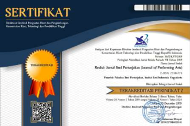Orkestra sebagai Peristiwa Mediasi: Jakarta City Philharmonic, Tubuh dan Materialitas
Abstract
Keywords
Full Text:
PDFReferences
Abels, B., & Titus, B. (2020). the world of music ( new series ) Choreomusicology I Corporeality | Social Relations the world of music ( new series ). 9.
Bibu N., Brancu, L., Teohari G. A. 2018. Managing a Symphony Orchestra in Times of Change; Behind the Curtains. Procedia - Social and Behavioral Sciences 238 (2018) 507 – 516. Amsterdam: Elsevier.
Boëthius S. B., Wrangsjö B. 1986. Managing Art; A case study of a symphony orchestra. First International Symposium on Group Relations, Keble College, Oxford July 15-18, 1986.
Bowman, W. (2000). A Somatic , " Here and Now " Semantic : Music , Body , and Self Author ( s ): Wayne Bowman Source : Bulletin of the Council for Research in Music Education , Spring , 2000 , No . 144 , The Dallas Papers of the MayDay Group (Spring , 2000 ), pp . 45-60 Pu. 144, 45–60.
Csordas, T. J. (1990). Embodiment as a Paradigm for Anthropology. Ethos, 18(1), 5–47. https://doi.org/10.1525/eth.1990.18.1.02a00010
Danusiri, Aryo. 2021. “Figur-Figur Digital.”Journal Antropologi Indonesia 42(1).
Deleuze, Gilles. 1994. Difference and Repetition. Columbia University Press.
Frederickson, J. (n.d.). Jon F. - Technology and Music Performance in the Age of Mechanical Reproduction.pdf.
Hardjana, Suka. (2004). Esai & Kritik Musik. Yogyakarta: Galang Press.
Hardjana, Suka. (2004). Musik: Antara Kritik dan Apresiasi. Jakarta: Kompas.
Harsawibawa, A. (2017). Disrupsi dalam Musik. Jurnal Resital Vol. 18 No. 3, Desember 2017: 144-158.
Heidegger, M. (2014). The Question Concerning Technology. In Philosophy of Technology: The Technological Condition: An Anthology (Second Edi, pp. 299–317). John Wiley & Sons, Inc. https://doi.org/10.5840/philtoday201054supplement53
Irawati, Eli. (2021). Transmisi, Kesinambungan & Ekosistem Kunci 'Musik Tradisi. Yogyakarta: Art Music Today.
Koivunen, N., & Wennes, G. (2011). Show us the sound! Aesthetic leadership of symphony orchestra conductors. Leadership, 7(1), 51–71. https://doi.org/10.1177/1742715010386865
Latour, B. (1992). Reassembling the Social: An Introduction to Actor-Network-Theory (Clarendon Lectures in Management Studies).
Latour, Bruno. (1990). “Technology Is Society Made Durable.” The) Sociological Review 38(1_suppl):103–31. doi: 10.1111/j.1467-954X.1990.tb03350.x.
Lokki, T., & Pätynen, J. (2018). Concert halls should primary please the ear, not the eye. Proceedings of the Institute of Acoustics, 40, 378–385.
Mashino, A. (2020). The Body Visualising the Music: Seeing and Showing Body Movement in Balinese gender wayang. World of Music, 9(1), 47–66.
Mccoy, C. W. (1994). Eurhythmics: Enhancing the Music-Body-Mind Connection in Conductor Training. Source: The Choral Journal, 35(5), 21–28.
Pätynen, J., & Lokki, T. (2016a). Concert halls with strong and lateral sound increase the emotional impact of orchestra music. The Journal of the Acoustical Society of America, 139(3), 1214–1224. https://doi.org/10.1121/1.4944038
Pätynen, J., & Lokki, T. (2016b). Perception of music dynamics in concert hall acoustics. The Journal of the Acoustical Society of America, 140(5), 3787–3798. https://doi.org/10.1121/1.4967157
Patynen, J., Tervo, S., & Lokki, T. (2015). Subjective Impact of Concert Hall Acoustics. Proceedings of the Institute of Acoustics, 37, 167–174.
Purnama, RY. A. P., (2009). Fotografi Pertunjukan: Fenomena Tubuh dari Panggung Menjadi Rupa. Jurnal Resital, Vol. 10 no.1 – Juni 2009: 72-79.
Reyland, N., & Thumpston, R. (2021). Music, Analysis, and the Body. In Music, Analysis, and the Body. https://doi.org/10.2307/j.ctv1q26wr0
DOI: https://doi.org/10.24821/resital.v23i1.6162
Refbacks
- There are currently no refbacks.
This work is licensed under a Creative Commons Attribution 4.0 International License.



